News
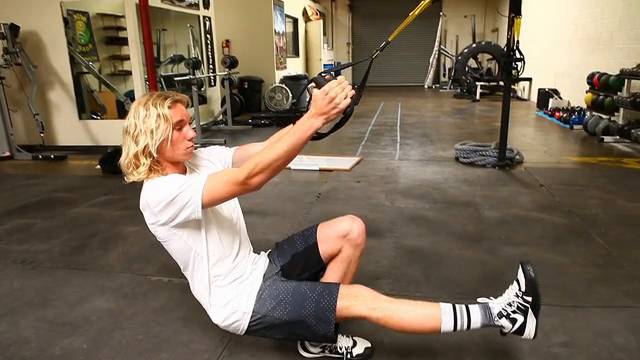
Four TRX Exercises for Surfing
Surfing requires a tremendous amount of upper-body and core strength, as well as cardiovascular endurance and skill. Whether you’re an elite-level surfer or your just trying to get the most out of your limited time in the water, doing some cross training can really help to improve your performance.
We've asked our friends at Extreme Athletics in Orange County, California to show us the tricks they use to train some of the world's best surfers, so you can take your game to the next level. Want to find the perfect surf-specific training for your skill level? Take our quick assessment quiz to get a customized workout plan that'll help improve your performance on the waves. Here is a sample of one of their surf-specific workouts:
TAKE OUR TRAINING QUIZ
Push Ups
Get into a plank position from your hands, with your elbows stacked under your shoulders. Engage your core, and do not allow your hips to sag. Use your arm and chest muscles to lower yourself down into until your chest touches the ground. At the bottom press your body back up to the start position in one, controlled motion.
TRX Atomic Push Ups:
Get in a pushup position with your feet in the foot cradles of the Suspension Trainer, directly under the anchor point. Brace your core and perform a pushup. When you reach the top of the push up, pause for a moment and pike your hips up while keeping your legs as straight as you can. Pause for a moment at the top, then lower your hips back down to the start position.
TRX Single Leg Squat:
Stand facing the TRX holding one handle in your right hand, plant your left foot in line with the anchor point. Lower your hips towards ground, keeping your right leg straight out in front of you. Drive through the heel of your left foot and extend your hips forward to stand. Repeat on both sides.
TRX Power Pull:
Stand facing the anchor point, holding one handle of the Suspension Trainer with one hand tucked into your side and your free hand reaching up toward the anchor point. Brace your core and focus on maintaining a solid plank position. Slowly lower your body away from the anchor point with your working hand, letting yourself rotate away, until your non-working hand is reaching toward the ground. Maintain your plank. Pull yourself back to the start position in one controlled movement until your non-working hand is touching the Suspension Trainer. Repeat on both sides.
TRX Abducted Lunge:
Stand sideways to the TRX and place the arch of your foot closest to the straps in both foot cradles. Hold your arms straight out in front of you and keep shoulders over hips. Lower your hips down and back, allowing your suspended leg to move away from body. Keep your chest tall and your eyes focused out ahead of you. Squeeze your gluts and drive through the inner thigh of your suspended leg to return.
Perform each exercise for 60 seconds with 30 seconds rest in between exercises. Repeat the entire sequence 1-3 times through, 2-4 times a week to see optimal results.
Want more TRX for surfing? Try the TRX Surf Stronger Workout.
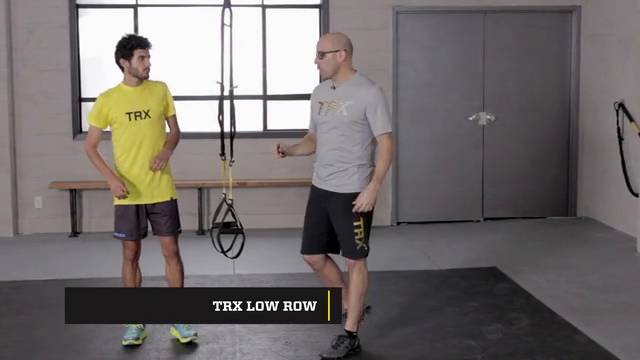
For the Love of the Run Week Two: Knee Drive and Posture
Improving your running mechanics can greatly impact your speed, efficiency and overall performance, as well as decrease your likelihood of injury. Our For the Love of the Run series provides you with some super helpful tips and tricks to help you perfect your running techniques and develop better functional movements so you can run stronger, longer.
In this installation, we take a look at building better posture and knee drive, as well as improving hip and ankle mobility. These exercises will make your stride more even and consistent, and help to identify any imbalances in strength or mobility you may have across your left and right sides.
TRX Lateral LungeLogic:Though running is mostly a linear activity, it’s really important to develop your ability to move from side to side as well. Improving your hip mobility and single-leg strength and stability will help you while pivoting, turning or running on uneven surfaces - particularly helpful for trail running.
Set Up:Stand facing the anchor point with your feet about double-shoulder-width apart, holding the Suspension Trainer by the handles. Brace your core and keep your head and chest up before your start moving.
Movement:Drive through your left foot in order to lunge down on your right side. Let your hips drop down and back, and maintain an upright torso, with your shoulders pulled back. Keep your feet flat. Focus on opening up the inner thigh of your non-lunging leg.
Return:Drive through your lunging leg to return to center, pausing for a moment to reestablish your plank, then repeat on the other side.
TRX Forward Lunge to ILogic:This exercise increases flexibility in the hip flexors while teaching you to generate power through your core. This will help to improve knee drive and maintaining good posture, especially when running up hills or stairs.
Set Up:Stand facing away from the anchor point holding the handles with your hands and your arms straight out in front of you.
Movement:Lunge forward until your front knee is bent at 90 degrees, letting the knee of your trail leg kiss the ground. As you lunge down, your arms should go directly overhead, unloading your legs slightly so you can focus on the stretch.
Return:Brace your core, press your hands into the handles and drive through your front foot to return to the start. Reestablish your plank before repeating on the other side.
TRX Low RowLogic:When fatigued, runners have a tendency to internally rotate their shoulders, putting their torso in an inefficient position from both a mechanics and a oxygen-uptake standpoint. This exercise will strengthen the core and shoulders to reinforce good position throughout the full duration of a run.
Set Up:Stand facing the anchor point and lean back while holding your self up with the Suspension Trainer. Brace your core and focus establishing a strong plank with your shoulders pulled down and back.
Movement:Maintaining your plank, use your back muscles to pull your chest up to your hands.
Return:Lower yourself down in one slow, controlled movement.
TRX Balance Lunge:Logic:Build single-leg strength, balance and stability to produce an even and efficient stride.
Set Up:Stand on one foot facing the anchor holding on to the handles of the Suspension Trainer.
Movement:Lunge back until your front knee is bent to 90 degrees, letting your rear foot hover above the ground and keeping shoulders, chest and eyes up.
Return:Use your glute and hamstring to bring you back up to the top. Pause for a moment to reset your plank before starting the next rep.
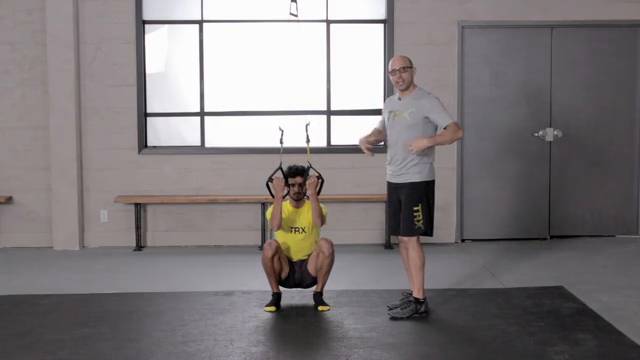
For the Love of the Run Week Three: Lower-Body and Core Strength for Runners
As a runner, developing integrated lower and upper-body strength, especially through your core, will result in a more powerful and efficient stride. Though it may seem a little counter-intuitive, your upper body and core actually play a big part in generating power and maintaining stability while you run.
Try these three TRX exercises for creating core strength, stability and mobility in runners and watch your performance soar:
TRX Bottom Up SquatLogic:Improve mobility in the hips and ankles while warming up the entire body for any training session. This exercise also teaches you how to engage your core and arms to improve your running posture, key for efficient breathing and arm drive.
Set Up:Stand facing the anchor point holding the TRX handles in front of you with your feet about hip width apart. Squat down and curl yourself up with your arms. Hop around a little until you get in a position where you feel like you could let go of the Suspension Trainer and you wouldn’t fall back.
Movement:Brace your core and drive through your feet to stand up. As you stand up, rotate your palms around until you are performing a triceps press.Reestablish your plank at the top of your squat.
Return:Lower your hips down and back to return to the bottom of the squat.
TRX Hamstring RunnerLogic:Develop your posterior chain, hamstrings, lower back and glutes to help correct imbalances not only from front to back, but also from side to side.
Set Up:Lay on your back with your heels in the foot cradles, directly under the anchor point. Drive your heels down, squeeze your glutes and brace your core to lift your hips. Imagine you are performing a plank on your back.
Movement:Without letting the straps slip, draw one knee toward you and keep your other leg out straight. Try to focus more on keeping your non-moving leg straight, instead of your moving leg.
Return:Press your foot back out and repeat on the opposite leg.
TRX Chest PressLogic:Think of this move as a moving plank instead of a chest and arm exercise. With this movement you are developing integrated core strength and stability to improve your running posture and arm drive.
Set Up:Stand facing away from the anchor point holding the handles of the Suspension Trainer out in front of you. Brace your core and lean your weight into the handles, making sure your hips, shoulders, knees and ankles are all in line.
Movement:Bend your arms at the elbows to lower yourself down in one controlled motion until your palms are at the side of your chest.
Return:Brace your core and squeeze your glutes to reestablish your plank, then drive your hands through the handles until your arms are fully extended out in front of you.
Recommended Workout Sequence:TRX Bottom Up Squat: 5-10 repsTRX Hamstring Runner: 5 reps on each legTRX Chest Press: 5-10 reps
For more running-specific workouts from TRX go here.
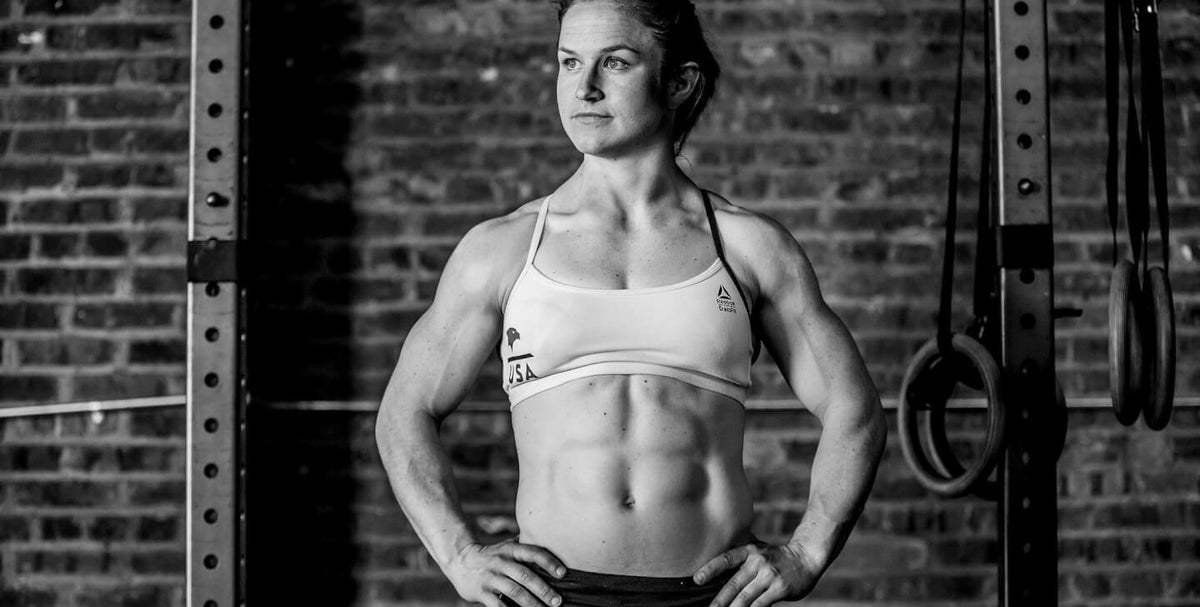
Food for Thought: What Kari Pearce Eats Before, After, and During Competition
Kari Pearce has used TRX training tools for years, first as a gymnast, and now as one of the world’s top CrossFit athletes. This summer, TRX is chronicling Kari’s journey to the CrossFit Games with a weekly series about her training program.
“It makes me feel better to eat right and train properly,” elite CrossFitter Kari Pearce says. “I notice a difference in how my body feels.” For Pearce, that means consuming clean, whole foods, and the occasional Lucky Charms. But more on those later.
Pearce has been an athlete her entire life—from gymnast to bodybuilder to CrossFitter—but she became more thoughtful about her diet after she finished college. “When I was gymnast, I tried to eat healthy, but I also ate a lot of other junk. I didn’t pay as much attention to my nutrition or think about how it would affect my performance,” she recalls. One obstacle was that certain foods—like yogurt or granola—sound healthy, but frequently hide unnecessary sugar and additives. “Now that I’m older, I enjoy learning about it, changing things and seeing how my body reacts,” she says.
With the CrossFit Games approaching, and her workouts ramping up, Pearce is extra-careful about her food choices. She works with Renaissance Periodization, (a company that uses science and research to create food programs for athletes), and Kettlebell Kitchen, (a Brooklyn-based meal service), to ensure she’s getting exactly what her body needs to perform.
Pearce eats as many as five small meals and a protein shake during a day. It’s not just a matter of eating frequently, but choosing the right balance of food categories. On a typical day, she has a combination of chicken, eggs, veggies, peanut butter, and lots of oatmeal. (“It’s easy. You can carry it anywhere. You just need hot water to cook it. It’s one of the things I carry most with me when I travel,” she says.)
Portion sizes vary according to the time of day—and what time she’s working out—but Pearce consumes as much as 75 grams of carbs, 3 ounces of protein, 1–2 servings of fat, and vegetables in a single meal. “My favorite meal is chicken with grilled peppers and onions, black bean salsa, and avocado. I think I could eat that for the rest of my life if someone would cook it for me everyday,” she says. Her vitamins and nutrients come from food—the only supplement she takes regularly is fish oil—and she doesn’t drink alcohol. “I don’t really enjoy it,” she says. “If I’m going to get extra calories, I want ice cream, not alcohol.”
Even when she travels, Pearce sticks to her meal plan by packing a cooler with prepared meals, or finding a hotel room with a kitchen so she can do her own meal prep. In a bind, she eats oatmeal or canned tuna. “I’ll go out some,” she says, “but I try to eat as much of my food as I can. If I eat out and I eat junk, I can really feel the difference in my energy levels.”
Traveling for CrossFit Regionals or the CrossFit Games requires a little extra meal packing...and a “magically delicious” snack. For her last Regional competition, Pearce’s consultant at Renaissance Periodization wrote her a nutritional program, and recommended a simple sugar between events. Yes, he actually told her to eat Lucky Charms. The cereal has been her favorite for years; Pearce says her dad even discovered chocolate Lucky Charms when she was in college, and would bring her boxes when he visited. “So I eat Lucky Charms with some lean chicken or protein [during competition],” she admits. “I just bring a big bag of Lucky Charms with me.”
After competition, Pearce goes out for Mexican food—she loves fish tacos, guacamole, and fajitas—and ice cream. Then it’s back to the meal plan. Because even if she tops the podium at this year’s Games, there’s always another goal to train for.
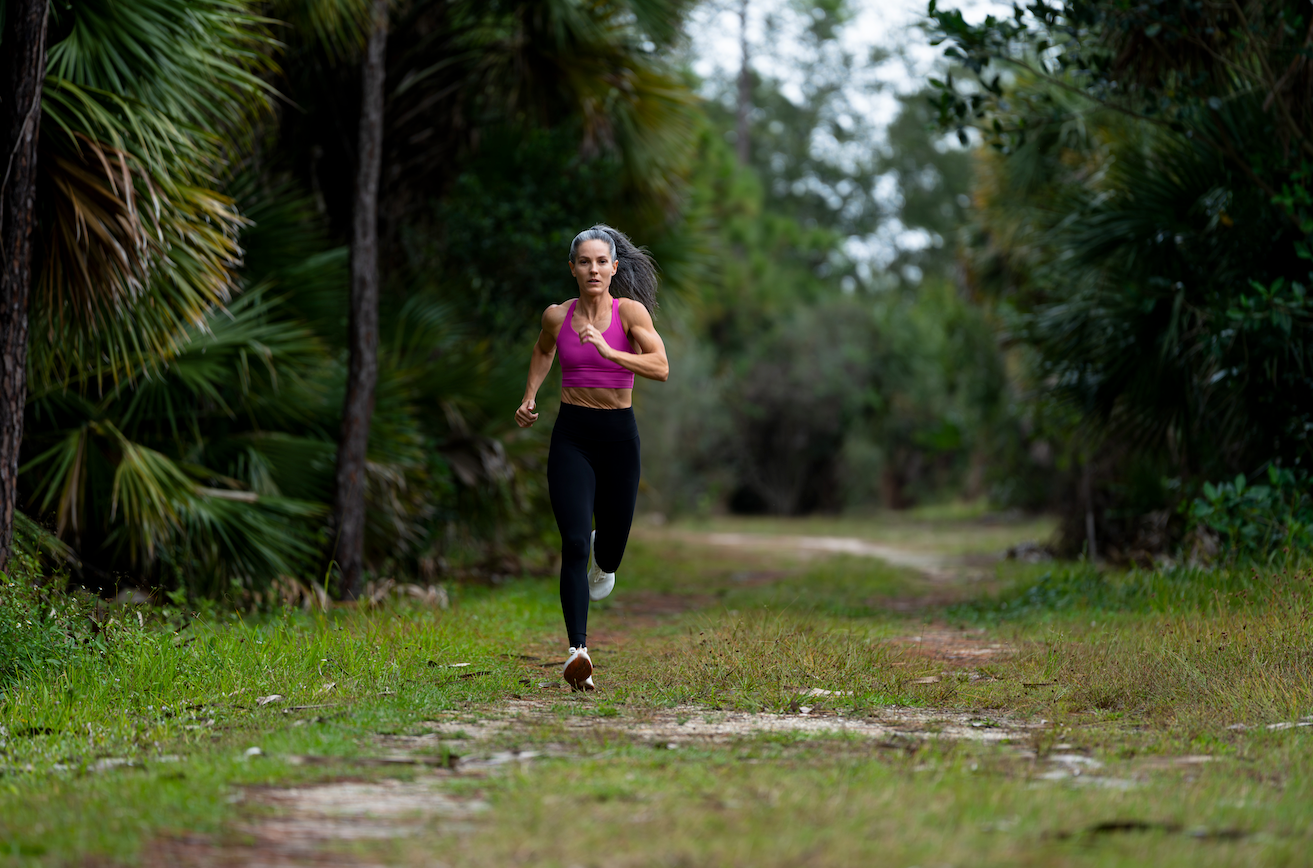
General
For the Love of the Run: Leg Strength and Core Stability for Runners
TRX Training
Imbalances in your leg strength and mobility between your left and right side can give you an uneven and inefficient stride. Over time, these imbalances can lead to overuse injuries.
These TRX exercises provide an excellent way to recognize, improve and ultimately, overcome those imbalances. Want to find exercises that address your specific muscle imbalances? Take our quick assessment quiz to get a personalized training plan. So you can do what you love, longer and more pain free.
TAKE OUR TRAINING QUIZ
Here's what you'll need:
TRX® PRO4 SYSTEM
BUY NOW
PRO4 RUNNER BUNDLE
BUY NOW
TRX® TRAINING MAT
BUY NOW
TRX Forward Lunge to I Fly (Advanced Progression) Logic:This exercise develops mobility in your hip flexors, stability in your core and improves single-leg balance and coordination, all helpful components in evening out your stride. If you’ve already mastered this progression of the exercise, try trailing the hand of your working leg and alternate from side to side to increase the stretch and develop some running-specific coordination.
Set Up:Stand facing away from the anchor point holding the handles with your hands and your arms straight out in front of you.
Movement:Lunge forward until your front knee is bent at 90 degrees, letting the knee of your trail leg kiss the ground. As you lunge down, your arms should go directly overhead, unloading your legs slightly so you can focus on the stretch.
Return:Brace your core, press your hands into the handles and drive through your front foot to return to the start. Reestablish your plank before repeating on the other side.
TRX Single Arm RowLogic:Not only with this move improve your arm drive and posture, making your run more efficient and powerful, but it also will improve durability. Because we’ve modified this to a single-arm progression, you’ll be resisting rotation the entire time, helping you develop better 360-degree stability so your can better handle the high impact and changing surfaces while you’re running.
Set Up:Stand facing the anchor point and lean back while holding your self up with the Suspension Trainer in one hand. Brace your core and focus establishing a strong plank with your shoulders pulled down and back.
Movement:Maintaining your plank, use your back muscles to pull your chest up to your hand. It can be helpful to use your non-working hand to mirror your working hand ensuring you’re body is totally even, throughout the movement.
Return:Lower yourself down in one slow, controlled movement.
TRX Suspended LungeLogic:Probably one of the single best exercises you can do to recognize and correct imbalances between your left and right sides, there is no hiding from this move. Core strength, single-leg stability, balance, mobility- this exercise has it all.
Set Up:Stand facing away from the Suspension Trainer with one leg through both of the foot cradles. Ground yourself through your working leg and find your plank before you start moving.
Movement:Push your hips down and back, and lunge down until your front knee is bent to 90 degrees. Keep your core braced and your chest up the entire time, and let your arms match your stride pattern, mimicking the way your run.
Return:Drive through your front foot and use your glute and hamstring to bring you back up to the top. Pause for a moment to reset your plank before starting the net rep.
Recommended Workout Sequence:TRX Forward Lunge to I Fly: 5-10 reps on each sideTRX Single Arm Row: 5-10 reps on each sideTRX Suspended Lunge: 3-8 reps on each side
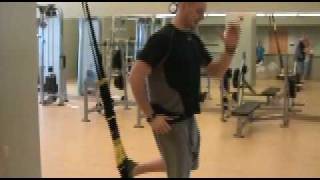
Five TRX Exercises for Basketball Players
With March Madness in full force, we figured that many of you out there might want a little basketball-inspired training to work out your broken-bracket aggression.
TRX Director of Human Performance Chris Frankel hand picked these five exercises to help basketball players improve their quickness, agility, power, explosiveness and leaping ability. Want to find the perfect TRX exercises to enhance your game? Take our quick assessment quiz to get a personalized basketball training plan.
TAKE OUR TRAINING QUIZ
In the video above, TRX Instructor Casey Stutzman takes you through our "starting five" TRX exercises designed to help get you game ready. They are:
TRX Lunge - Builds single leg strength, deceleration, acceleration and balance, works the posterior chain and integrates functional core strength all at once
TRX Atomic Push-up - Integrates chest and shoulder stability, core strength, power and high intensity cardio training
TRX Side Plank - Develops lateral core strength and stability
TRX Crossing Balance Lunge - Works the hips, legs and core in a multiplanar single leg stance
TRX Power Pull - Integrates multiplanar back, shoulder and core training in a standing position
As always, make sure you warm up properly and select the appropriate intensity for your fitness and ability level. See you on the court!
Get your TRX Suspension Trainer here.
Casey Stutzman is a TRX Instructor and travels the US teaching TRX Professional Education Courses. Casey has been using TRX Training for over three years in his role as Head Trainer at Bay Athletic Club in Alpena, Michigan as well as coach of the Alpena High School girls' basketball team. He holds certifications through the American Fitness Association of American (AFAA) as well as Under Armour’s Combine 360. Casey is also a competitive bodybuilder.
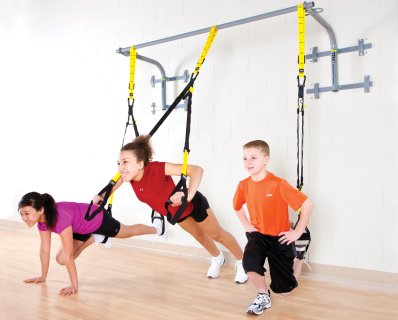
FitDeck: TRX Suspension Trainer
Just when you thought that we could not make the TRX any more fun, we went and made a game out of it. We have partnered with FitDeck, the fitness deck of cards to help build a foundation of fitness by creating hundreds of basic workouts that are, simple, convenient and fun. Together we developed the FitDeck TRX Suspension Trainer. This deck of cards is specifically designed to challenge your exercise routine and keep it fresh and interesting.
This deck of 26 cards can be used on their own or combined with other FitDecks to maximize your possibilities. The simplest way to use the deck is to shuffle the deck, pull the top card, do the exercise and then work your way through the pile. But that is not the only way to use it. Check out FitDeck's suggested games or come up with some of your own.
We at TRX have always been dedicated to making fitness challenging and fun and what better way than to make a game out of it! Want to discover workouts that match your idea of fun fitness? Take our quick assessment quiz to get personalized exercise recommendations that keep you motivated and engaged.
TAKE OUR TRAINING QUIZ
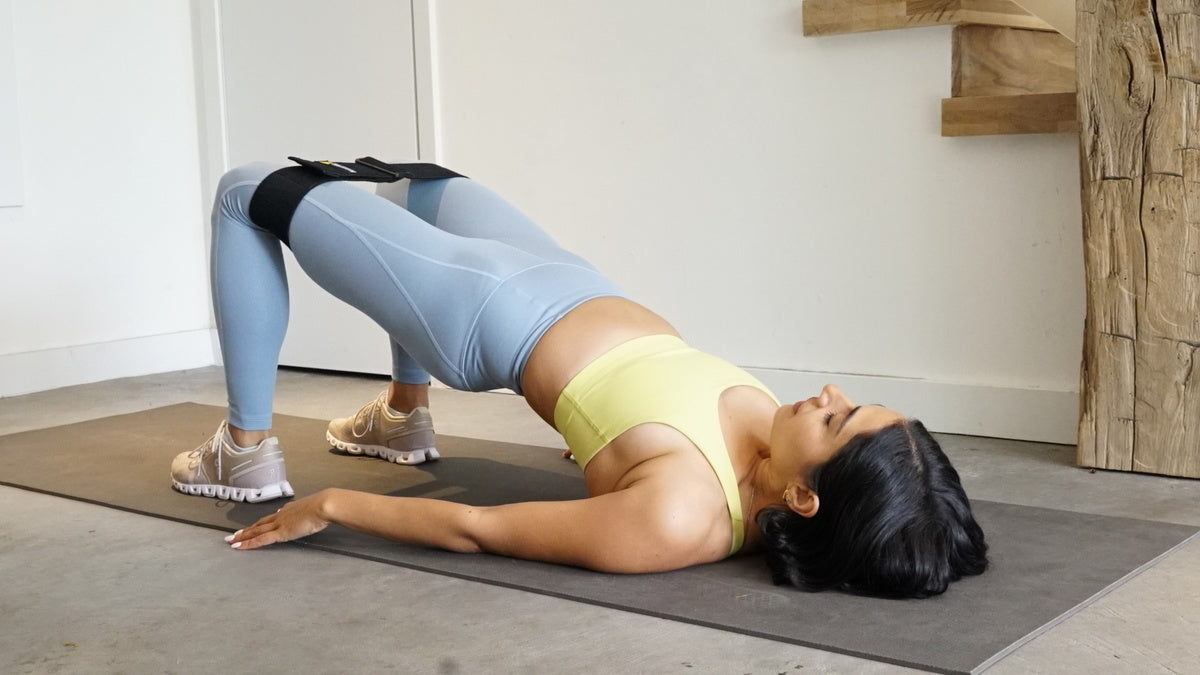
Everything You Need to Know About Resistance Bands
TRX Training
If your TRX Training ClubSM workout calls for Strength Bands or any other type of resistance training equipment, do you automatically know which elasticized accessory to grab? Want to find the right resistance bands for your fitness goals? Take our quick assessment quiz to get personalized equipment recommendations. There are lots of bands in the fitness world, and most people don't know which one's which. That changes now. We're doing a deep dive into everything you need to know about TRX Strength Bands, Glute Bands, and Exercise Bands. In just a few minutes, you'll be a band expert.
TAKE OUR TRAINING QUIZ
Oh, the Many Bands You’ll Meet
The smallest, lightest bands on the block are the Exercise Bands. They’re a continuous loop made from rubber latex, and are about 10 inches in diameter. (Think: giant rubber band, specifically made for fitness.) Exercise bands are usually reserved for low-impact training, rehabilitation, stretching and mobility.
While you can easily program a full-body, 30-minute workout using only an Exercise Band, you’ll usually spot these being used for isolated hip work and rotator cuff targeting. For example, you could place a lightweight Exercise Band around your forearms while planking, or slide a medium or heavy Exercise Band around your thighs to drive up the intensity of squats or planks.
For a booty-boosting workout, TRX Glute Bands are your new best friend. Unlike the Exercise Bands, our Glute Bands are made from fabric and they’re velcro-adjustable. Available in light, medium, and heavy resistance, they won’t pull at your skin or hair.
Also, did we mention they’re crazy-effective for toning the glutes and hip flexors? Even the “light” Glute Band delivers enough burn to make you double check the label.
Rounding out the collection are the Strength Bands, which are approximately 3-ft. long, continuous, heavy-gauge rubber loops. They’re the ones usually hanging on the wall at the gym because, frankly, most folks find them uncomfortable. Even TRX founder Randy Hetrick, a former Navy SEAL, admitted that he used to avoid Strength Bands because they pinched his hands. That’s why he created the TRX Bandit, a universal handle that lets Strength Bands finally—finally!—realize their potential.
Slip the Bandit over (almost) any Strength Band, and you’ve got a high-impact, low maintenance system for squats, curls, presses, and rotational power.
Before we move on from identifying bands, let’s not forget about that other on-the-go tool that we all love: The Straps! The TRX Suspension Trainer™ is not elastic, but it’s still a one-size fits all strength training superstar. When you’re looking to add extra burn to your Suspension Training® workout, try adding Exercise Bands to TRX Rows, Bicep Curls or Tricep Dip, or Glute Bands to any of your TRX Planks.
If you want quality tension, get your resistance bands here today:
TRX® RESISTANCE BANDS
BUY NOW
TRX® STRENGTH BANDS
BUY NOW
TRX® GLUTE BANDS
BUY NOW
Why are people obsessed with bands?
Resistance bands are affordable, portable, and efficient—a triple threat that can appeal to any fitness enthusiast.
First, let’s talk affordability. We’re not saying that bands are the best or only way to workout, but they’re the cheapest option that doesn’t cut back on quality.
Basic, lightweight TRX Exercise Bands cost less than $4 each, or you can buy a full set for less than $15. TRX Strength bands, which you can use as a substitute for weight-training exercises, start at $10.95. Even our most expensive resistance bands, the TRX Glute Bands, are only $39.95 for a set of three, plus they come with their own mesh travel bag. (Pro-tip: the bag is big enough to fit the Exercise Bands, too, if you want to store everything in one place.)
Next, there’s the portability factor. Maybe you’re the person who brings a collection of kettlebells wherever you go, but the average person doesn’t want to lug extra weight. Resistance bands produce similar benefits to weights, but they’re lightweight and compact. You want a gym you can squeeze into a fanny pack? Invest in bands.
Finally, there’s the efficiency consideration. Whether you opt for Exercise Bands for light toning, or Strength Bands outfitted with the new TRX Bandit as a substitute for cable-powered lifting, bands give you the freedom to crush serious workouts absolutely anywhere.
Ready to move?
You didn’t think we could tell you everything you need to know about resistance bands without sharing workout suggestions, did you?
Exercise Band Extras
In a plank position, try adding TRX Exercise Bands around your forearms (in a high plank) or above your elbows (in a low plank) to challenge both your upper body mobility and your core stability. Trust and believe, the burn will set in fast. You can also try slipping an Exercise Band over your feet—around midfoot—for an amped-up Mountain Climber, Bicycle Crunch, Dead Bug, or Slow March.
Bonus Points on the Straps: Remember you can add the Exercise Band around your forearms when using your Suspension Trainer for upper body exercises like TRX Rows and Tricep Dips!
Glute Band Burn
Whether you’re squatting with bodyweight or loaded weights, adding a Glute Band will shred your bum in the best way. Start with a basic squat, then experiment with jumps or lateral squat steps. When it’s time to hit the mat, you could also use the Glute Band to drive up the intensity of Fire Hydrant Lifts or Donkey Kicks.
Bonus Points on the Straps: Slip on a Glute Band before you rep out your TRX Front Squats, Planks, or Pikes. Warning: May result in extreme soreness and bragging rights.
Strength Bands For the Win
Armed with your Bandit handles, there’s no limit to what you can do with Strength Bands. Consider super-setting exercises, first with your bands, then with your Suspension Trainer to compare how different tools affect your movement. Start with a Bandit Squat paired with a TRX Squat, then try a Bandit Chest Press with a TRX Chest Press, and finish with Bandit Lateral Raises followed by TRX Y-Flies.
There’s plenty of room in the fitness world for weights, Suspension Training®, and resistance. Look past the “either/or'' dilemma when choosing gear, and embrace introducing tools like resistance bands to keep your body guessing. Remember, change makes your workouts interesting and enjoyable, and increases their overall effectiveness.
Still looking for more tips and tricks with bands? Don’t forget that you can filter TRX Training ClubSM on-demand videos for the specific equipment you’re using, including Strength Bands, Glute Bands, Exercise Bands, Bandit, and—of course—the Suspension Trainer.
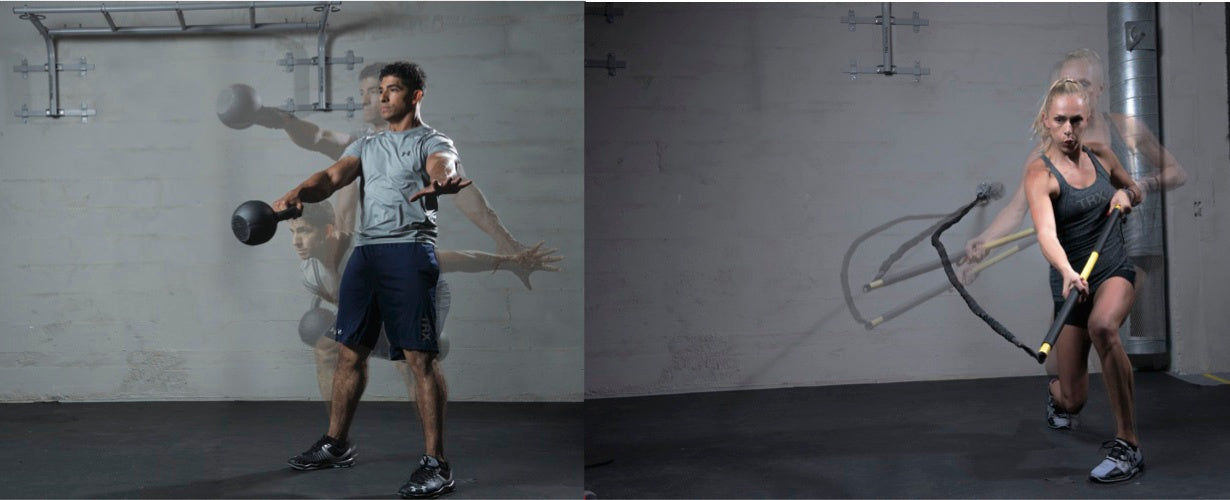
Everything You Need to Build the Ultimate Golfer Home Gym
Depending on whom you ask, the game of golf is approximately 250 to 450 years old. But, despite its advanced age, there’s been a major shift in golf over the last 20 years: top players have branched out beyond technical skills and found ways to improve their game through fitness. Even if you’re not vying for endorsement deals or a spot on the PGA Tour, the right exercises can help you play better on the course, and feel better after the game is over. Want to build the ultimate golfer home gym? Here are five tools that experts recommend to help you train to be a better golfer.
TRX Suspension Trainer ($199.95)
Whether you’re using it at home, at the gym, or setting it up on your golf cart, the Suspension Trainer gives golfers a quick way to build in resistance training and core work. Chris Frankel, TRX Head of Human Performance and a former PGA Tour trainer, says even the pros love this tool. Frankel recommends packing it for pre-game exercises to open up the chest, loosen up the shoulders, and activate the core before hitting the green. Don’t forget to warm up with the TRX Golf Rotation!
TRX RIP Trainer ($199.95)
The RIP Trainer is perfect for golfers who want to improve their range of motion, particularly through the upper thoracic spine, shoulders, and hips. Golf coaches and fitness professionals love that the RIP Trainer emphasizes every degree in the range of motion to help identify weaknesses in rotational movement. It’s the ideal way to combine ground reaction force, rotational power, and body awareness to improve your golf game.
Kettlebells ($34.95-$119.95)
If you want to improve your drive, you have to focus on getting force into the ground. Kettlebells can help. Start with simple deadlift exercises, and then work on developing a strong kettlebell swing. Kettlebell exercises can increase strength and power in your hips and help you drive the ball further.
Slam Balls ($29.95-$84.95)
Slam ball exercises improve both your overhead mechanics and your power into the ground. Taking time for simple rotational work with a slam ball can help you manage your footwork, your pivot mechanics through your legs, and your swing.
TRX Power Bag ($89.95-$99.95)
This is not your typical weight machine. The Power Bag offers limitless range of motion, all the better for identifying and strengthening your weaker points and motions. It’s ideal for challenging strength and balance. (For more Power Bag training tips, check out this article.)
If you love golf and you spend hours of your life playing the game, take some time to improve your game when you’re away from the course. These five tools—less than $600 total—are the best way to start your very own golfer home gym.
